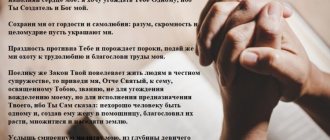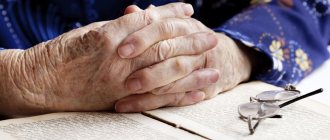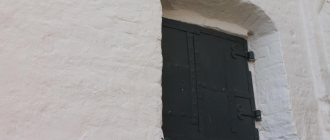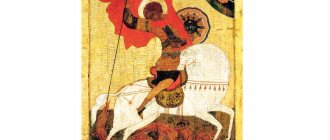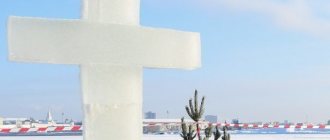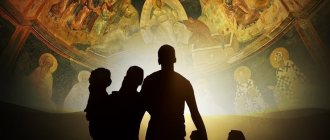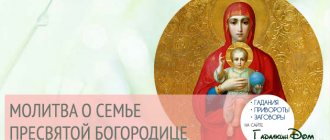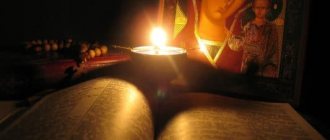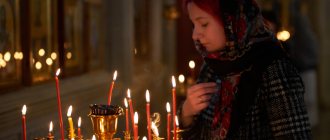Ascension David's hermitage in Novy Byt
Cathedral of the Ascension
In the Ascension Cathedral (left), the walls of the temple, erected in the 16th century, are partially preserved. Photo: Mikhail FROLOV
Construction of the temple began during the time of Ivan the Terrible. And if in other monasteries the first buildings were most often wooden, then here the Cathedral of the Ascension of the Lord immediately began to be built from stone. After some time, construction stopped, and the construction that had begun was dismantled. A new one was installed in its place and opened in 1682.
Znamensky Temple
The most striking church in the central ensemble of the desert was built later than all others. Photo: Mikhail FROLOV
The church received its name from the icon of the Mother of God “The Sign”. The temple was rebuilt several times: first there was a wooden chapel, then a bell tower was built, and only in the middle of the 19th century a temple appeared that has survived to this day.
Bell tower
The bell tower is made in the Russian-Byzantine style. Photo: Mikhail FROLOV
A bright multi-level bell tower 70 meters high rises above all the churches of the monastery. It has seven bells and a clock that play church hymns at 60-minute intervals.
St. Nicholas Church
St. Nicholas Church (right) is richly decorated. Photo: Mikhail FROLOV
Initially it was built close to the Cathedral of the Ascension of the Lord. This is what the temple complex looked like in the 18th century. But, a century later, the churches were “separated” due to everyday needs. We needed space for a kitchen and refectory. St. Nicholas Church was demolished and built a little further from the main cathedral.
Church of the Assumption of the Blessed Virgin Mary
The snow-white Church of the Assumption is located next to the Spassky Cathedral. Photo: Mikhail FROLOV
The White Church stands next to the Spassky Cathedral. In the 1730s, it became necessary to rebuild the Church of the Assumption of the Blessed Virgin Mary, as it began to collapse. I had to redo the floors and ceilings and change the iconostasis. The work ended in 1740.
Spassky Cathedral
The Spassky Cathedral (left) appeared in the place where there used to be a refectory. Photo: Mikhail FROLOV
One of the most striking buildings of the monastery: pink with white trim and dark domes that contrast with the main building. There was a refectory on this site, but in the 1900s another redevelopment of the monastery took place, and the Spassky Cathedral was opened.
Church of All Saints
The Church of All Saints is a yellow two-story building topped with a dome. Photo: Mikhail FROLOV
The yellow two-story building looks more like a residential building. If it weren't for the dark dome towering above it. However, in Soviet times it was not a church: the canteen of an agricultural technical school was located here. In the early 2000s, the Church of All Saints became operational and opened to parishioners.
Holy spring
It is located not on the territory of the monastery itself, but in its courtyard, the village of Talezh. It’s about 30 kilometers from the David Desert, about half an hour’s drive. The water in the source is always cold, +4 degrees. Here you can get water for drinking and take a dip in the plunge pool. Please note that the spring is open from 8:00 to 21:00.
Architectural ensemble
On the small plot of land that the monastery occupies, there are many buildings that make up a single ensemble. The architecture of the monastery is not similar to similar buildings in other monasteries. The monastery buildings are painted in warm, rich colors that blend organically with the surrounding landscape and instill a feeling of peace and tranquility.
The main entrance to the territory is the Holy Gate with the gate bell tower located above it. Having passed under the face of St. David, located above the entrance, parishioners find themselves in the inner territory of the monastery, which is fenced by a wall with four towers.
Monastery today
When approaching the village of Novy Byt, around one of the turns, a magnificent view will open up in front of you. From this place, the Holy Ascension David's Hermitage is perfectly visible - the entire architectural ensemble and its residential buildings.
After 63 years of desolation, the monastery came to life. The Cathedral of the All-Merciful Savior was transferred to the Orthodox community organized in the village of Novy Byt.
The Monastery of David's Hermitage was not restored easily. The abbot of the monastery faced a lot of problems, but did not give up on his goal. In 1995, Father German was brutally murdered. According to the official version, the crime was committed for the sake of profit - the monastery safe was robbed.
The magnificent restoration of the monastery is overshadowed by various rumors that shroud the process. The clergy are accused of accepting large donations for the restoration of the monastery from people with dubious reputations. This is Gennady Nedoseka and Anton Malevsky. Today in the monastery cemetery you can see their graves, which differ from other burials in their luxury. Malevsky is the former Russian “aluminum king” and the leader of the Izmailovo criminal group, Nedoseka is an employee of the administration of the city of Chekhov, with a very dubious reputation. Despite everything, thanks to the help of these, not the most righteous, people, David’s deserts were restored.
Abbots
- St. David of Serpukhov (May 31, 1515 - October 18, 1520)
- Trophyllium
- Kirill I
- Theodosius
- Akakiy
- Lavrentiy
- Ioannikios I
- Misail I
- Macarius
- Mercury I
- Alexander
- Euthymius
- Anthony I
- Leonidas I
- Leonty
- Mercury II
- Anthony II (1624 - 1639)
- Jonah (mentioned 1648 - 1650)
- Dionysius I (mentioned 1651)
- Savvaty I (1653 - 1657)
- Abraham I (mentioned 1658)
- Andreyan (mentioned 1658)
- Leonidas II (mentioned 1660)
- Philotheus (1664 - 1671)
- Abraham II (1676 - 1685)
- Lawrence (1687 - 1689)
- Savvaty II (1691 - 1702)
- Paul (1708)
- Cyril II (1709 - 1712)
- Ezekiel (1713 - 1719)
- Mitrofan (Sheinkov) (1719 - 1721)
- Dimitri (1721)
- Dionysius II (1721)
- Simon (1722 - 1727)
- Jacob (1727 - 1733)
- Filaret (December 21, 1734 - 1739)
- Joseph I (1740 - 1744)
- Hierotheus (1745 - 1753)
- Pachomius (May 20, 1754 - 1760)
- Gideon (1760 - 1761)
- Paisius I (1761)
- Nikon (1761 - 1765)
- Paisius II (1765 - 1766)
- Misail (September 4, 1766 - 1769)
- Barnabas (June 1770 - 1777)
- Irakli (Evreinov) (1777 - 1788)
- Joasaph (1788 - 1789)
- Joacinth (1789 - 1792)
- Sylvester (September 16, 1792 - 1796)
- Pavel (1796 - 1798)
- Joseph II (1798 - 1803)
- Arseny (1803 - 1816)
- Ioannikios II (1816 - 1832)
- Joseph III (1832 - 1833)
- Gennady (1833 - 1836)
- Afanasy (1838 - 1843)
- Paisiy (Sokolov) (1843 - 1854)
- Varlaam (1854 - 1865)
- Joseph IV (1865 - 1884)
- Ioannikios III (1884 - 1893)
- Valentin (Egorov) (1893 - April 1916)
- Ilariy (Babykin) (April 8, 1916 - October 30, 1916) acting
From 1929 to 1995 the monastery was closed
- German (Khapugin) (January 11 - May 5, 1995) acting
- Roman (Gavrilov) (August 8 - October 6, 2005) acting
Holy spring
Not far from the holy monastery, in the small village of Talezh, there is his farmstead. This place was made famous by a unique source. David's Hermitage, according to believers, is a truly unique place. The mentioned spring was consecrated in the name of St. David. For hundreds of years, it quenched the thirst of pilgrims. Orthodox Christians came here from all corners of the Russian land to drink the life-giving moisture. It was consecrated by the prayers of David, who went to this source on foot from the desert. In the courtyard there is a temple of the monk, there are baths. Everyone who has visited this place leaves here peaceful, with a particle of God’s grace in their soul.
Shrines and relics
The main shrine is kept in the Church of the Sign. Believers come to the relics of St. David of the Ascension to venerate and pray for help. In the same temple is kept the icon of the Most Holy Theotokos “The Sign”, with which the founder of the monastery came to the bank of the Lopasnya River and the ark with 150 particles of the relics of Orthodox saints. In the altar of the temple there is a particle of the Nail with which the Savior was crucified.
Patronal feast of the discovery of the relics of David of Serpukhov in the Ascension David Hermitage
In the Spassky Church there are arks with particles of the robes of Jesus Christ and the Mother of God. St. Nicholas Church contains fragments of the relics of Matrona of Moscow, Sergius of Radonezh, and the apostles Mark, Matthew and Luke.
More than 200 pieces of holy relics are collected in the monastery.
Attention! A full description of all relics can be seen in the official publications of the Holy Ascension David's Hermitage.
Reviews from guests of the monastery
The restored and restored Holy Ascension David's Hermitage does not leave anyone indifferent. Most guests of the monastery are delighted with how carefully and reverently they treat ancient church relics in the desert, and how the monastery Charter is revered. Many emphasize the friendliness of the clergy, who speak lovingly about the monastery and its history.
However, there are also negative reviews. As a rule, they are associated with the use of “unrighteous” money during the restoration of the monastery and the burial on its territory of people who at one time had problems with the law. It must be said that ordinary parishioners, pilgrims, and residents of nearby settlements also took part in the restoration of the desert (in addition to the indicated persons).
Be that as it may, David’s Hermitage (reviews from visitors confirm these words) is a unique monument of history and architecture of our country. Therefore, we recommend that you definitely visit this monastery.
Transfiguration
In order to save David’s Hermitage from the “abomination of desolation,” it was decided to turn it into a cenobitic monastery. In addition, send several monks from other monasteries to the decaying monastery. To build a communal spirit in it and get out of decline.
In 1799, the new inhabitants began restoring the desert. Both in repair terms and spiritually. The roof and walls were repaired, and a new order of worship and life for the inhabitants was introduced. And the number of the latter began to increase.
In the 19th century, the monastery was transformed more and more. It was then that the current bell tower was built. Two parochial schools were opened. There was a special purity in the life of the monastery. The temples were distinguished by their beauty, and the brethren by their deanery.
In 1915, the Holy David's Hermitage numbered over a hundred inhabitants. On its territory there were prosphora, junk, a wonderful garden, flower beds, and a cemetery. Outside the monastery there were a cattle and horse yard, a bathhouse, a mill, a beekeeper, and a parochial school.
